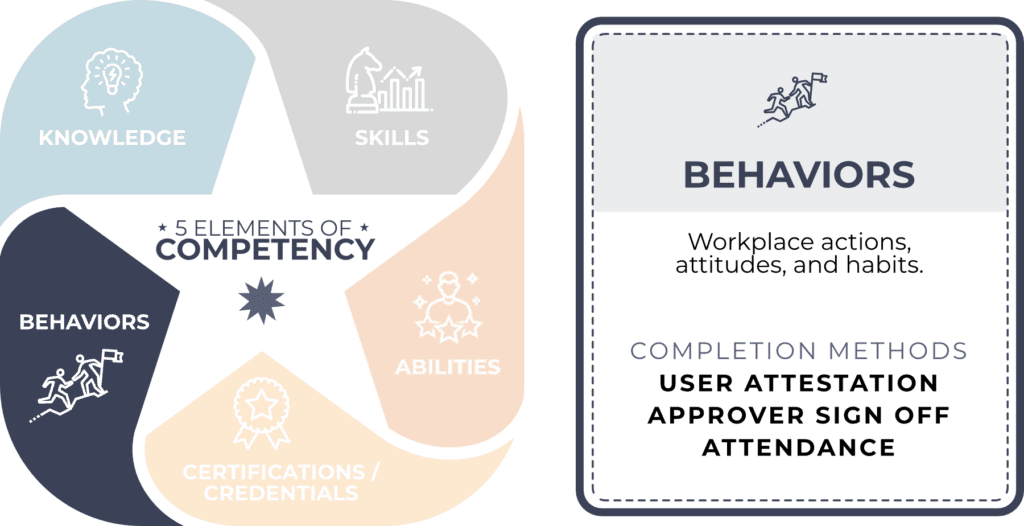A Close Look at Overt, Covert, and Social Behavior
The behavior element of competency management is crucial because it directly influences how skills and knowledge are applied in real-world scenarios. While technical competencies define what an individual can do, behavioral competencies determine how they perform tasks, interact with others, and navigate complex work environments. Effective competency management recognizes that success is not just about having the right skills but also about exhibiting the appropriate behaviors that align with organizational values and goals.
Focus on behavior in competency management can help organizations ensure that employees meet performance standards and contribute positively to the workplace culture. This leads to better team dynamics, higher employee engagement, and overall organizational success. This blog will examine the behavior framework closely, provide examples of each type of behavior, and break down the competencies associated with each behavior.

Classifications of Behaviors – Overt, Covert, and Social
The classification of behaviors into overt, covert, and social categories is a framework used in psychology to understand better and analyze different types of behavior. While various psychologists and theories have contributed to these concepts, the framework is closely related to the work of behaviorists and cognitive psychologists.
- Overt Behavior – This refers to observable actions that can be seen and measured—behaviorists like B.F. Skinner focused on overt behaviors as they can be directly observed and studied. This idea is rooted in the behaviorist perspective, emphasizing observable actions rather than internal mental states.
- Covert Behavior – Covert behaviors are internal or private, such as thoughts, feelings, or memories, that are not directly observable by others. This concept is often associated with cognitive psychology and the work of figures like Jean Piaget and Aaron Beck, who explored internal mental processes. In behaviorism, covert behaviors are sometimes discussed in terms of “private events” that influence overt behavior.
- Social Behavior – Social behavior refers to actions that involve interactions with others and are influenced by social contexts and relationships. This idea aligns with social psychology, a field that examines how the presence and actions of others influence people’s thoughts, feelings, and behaviors. Key figures in social psychology include Kurt Lewin and Solomon Asch.
Overall, these categories help us understand the complexity of human behavior from different angles, incorporating observable actions, internal processes, and social interactions. Let’s take a look at some examples of each type of behavior.
Examples of each type of behavior:
Overt Behavior
- Speaking out loud: Talking to someone, giving a presentation.
- Physical actions: Walking, eating, writing.
- Facial expressions: Smiling, frowning, scowling.
- Gestures: Waving, pointing, shaking hands.
Covert Behavior
- Thoughts: Planning, daydreaming, analyzing a problem.
- Feelings: Experiencing anxiety, happiness, and sadness internally.
- Memories: Recalling past events, reminiscing.
- Internal decision-making: Weighing options, internal conflict.
Social Behavior
- Interacting with others: Conversing, collaborating, arguing.
- Social norms: Following etiquette and adhering to cultural practices.
- Group dynamics: Teamwork, leadership, influencing others.
- Nonverbal communication: Reading social cues and maintaining eye contact.
Each type of behavior offers a different perspective on how we act and react in various contexts.
Competency Management and Overt Behavior Competencies
In competency management, overt behaviors are the visible and measurable actions demonstrating an individual’s abilities. For example, in verbal communication, overt behaviors include the clarity with which a person speaks and how effectively they articulate their ideas during conversations or presentations. Nonverbal communication is reflected overtly through body language, facial expressions, and gestures that align with spoken words, clearly understanding the message. When it comes to motor skills, overt behaviors are seen in fine motor tasks like writing or typing, where precision and control are directly observable, as well as in gross motor skills like walking, running, or lifting, where the physical actions themselves can be easily measured.
In task execution, overt behaviors are evident in completing tasks within set deadlines, showcasing productivity, and managing time and resources, which reflects strong organizational skills. In social interactions, overt behaviors are displayed through collaboration, where an individual can work well with others and share responsibilities is visible. Conflict resolution is also overt when it involves directly addressing and resolving disputes, allowing for observable outcomes that contribute to a productive work environment.
Competency Management and Covert Behavior Competencies
In competency management, covert behaviors related to cognitive skills are often the unseen yet critical processes that drive effective performance. For instance, critical thinking involves the internal analysis and evaluation of information and arguments, which may take time to be apparent but are crucial in shaping well-informed decisions. Similarly, problem-solving encompasses the covert process of identifying and working through complex issues internally, where the real value lies in the thought processes rather than the outward display of solutions. Emotional intelligence relies heavily on covert behaviors, such as self-awareness, where individuals internally recognize and understand their emotions, and self-regulation, where they manage these emotions and reactions effectively, often without visible cues.
Memory and learning covertly manifest through recall, where past experiences or information are remembered and utilized internally, and adaptability, where one adjusts their thoughts and strategies based on new information, often without overt signals of this cognitive shift. In decision-making, covert behaviors include judgment, where informed decisions are made based on internal reasoning, and planning involves developing strategies and plans internally before any outward actions are taken. Though not always visible, these covert behaviors are essential for demonstrating deep competency in cognitive skills.
Competency Management and Social Behavior Competencies
In competency management, social behaviors are pivotal in demonstrating strong interpersonal skills essential for successful interactions in any environment. Empathy is a key social behavior where an individual not only understands but also shares the feelings of others, creating a foundation for trust and effective communication. Active listening is another critical social behavior involving attentive and thoughtful engagement with others’ words, ensuring that responses are well-considered and appropriate. In teamwork and collaboration, social behaviors such as coordination enable individuals to work seamlessly within a group, sharing tasks and responsibilities, while influence allows them to persuade and motivate others toward common goals positively.
Social awareness is reflected through behaviors like cultural sensitivity, which recognizes and respects cultural differences, and an understanding of social norms, which helps navigate and adhere to societal expectations. Networking also relies on social behaviors, as relationship-building is essential for establishing and maintaining professional and personal connections. Social engagement, demonstrated by active participation in and contribution to social activities and groups, further solidifies an individual’s competency in creating and sustaining meaningful interactions within their social environment.
These competencies help individuals function effectively across different contexts, whether interacting directly with the environment, managing internal processes, or engaging with others socially.
Proving Competencies with Overt, Covert, and Social Behavior
Proving competencies associated with overt, covert, and social behavior involves a combination of observation, assessment, and evaluation methods. Here’s a structured approach to demonstrating these competencies:
Proving Competencies in Overt Behavior
- Direct Observation
- Documentation: Record observable actions and behaviors, such as speaking, writing, or physical activities.
- Performance Reviews: Use performance appraisals to assess how effectively someone completes tasks and interacts in observable ways.
- Skill Assessments
- Tests and Exercises: Administer tests that measure verbal communication, motor skills, or task execution abilities.
- Simulation: Use simulations or role-playing exercises to evaluate how individuals perform specific tasks or actions.
- Feedback
- Peer Reviews: Collect feedback from colleagues or supervisors regarding an individual’s observable skills and actions.
- Self-Assessments: Have individuals assess their own observable behavior and task completion.
Proving Competencies in Covert Behavior
- Self-Report Instruments
- Surveys and Questionnaires: Use tools to assess self-awareness, emotional intelligence, decision-making, and cognitive skills.
- Journals: Ask individuals to keep a reflective journal to document their internal thought processes, decision-making, and emotional responses.
- Psychometric Testing
- Cognitive Tests: Administer tests designed to measure critical thinking, problem-solving, and memory.
- Emotional Intelligence Assessments: Use standardized tests to evaluate emotional self-awareness, regulation, and other aspects of emotional intelligence.
- Case Studies
- In-Depth Analysis: Analyze specific instances where covert behaviors, such as internal decision-making or emotional responses, influenced outcomes.
- Interviews: Conduct interviews to explore how individuals handle internal processes and decisions.
Proving Competencies in Social Behavior
- Social Interaction Analysis
- Behavioral Observations: Observe and analyze how individuals interact with others, including empathy, teamwork, and conflict resolution.
- Social Situations: Evaluate performance in group settings, such as meetings or collaborative projects.
- Feedback and Reviews
- 360-Degree Feedback: Gather feedback from peers, subordinates, and supervisors to assess social skills and interpersonal effectiveness.
- Client/Customer Feedback: Collect feedback from external interactions to evaluate relationship-building and networking abilities.
- Role-Playing and Simulations
- Scenario-Based Exercises: Use role-playing or simulations to assess how individuals handle social situations, including negotiation, collaboration, and influence.
- Social Network Analysis
- Network Mapping: Analyze the strength and effectiveness of an individual’s social connections and professional relationships.
- Engagement Metrics: Measure participation and contribution to social or professional groups.
General Methods for Proving Competencies
- Behavioral Evidence
- Documentation of Achievements: Record specific instances where competencies have been demonstrated effectively.
- Project Outcomes: Use successful project outcomes as evidence of effective behavior.
- Comparative Analysis
- Benchmarking: Compare an individual’s competencies against established benchmarks or standards in the field.
- Performance Metrics: Analyze performance metrics related to specific competencies, such as task completion rates or feedback scores.
- Training and Development Records
- Certifications: Use certifications or training records to demonstrate skill acquisition and development in relevant competencies.
- Progress Tracking: Track progress over time to show development and mastery of competencies.
These approaches provide a comprehensive way to demonstrate and prove competencies in overt, covert, and social behaviors using a combination of direct evidence, self-reporting, and feedback mechanisms.
At CABEM, we recognize five key competency elements. Behavior is one of these key components. Cultivating positive behaviors fosters a productive and ethical workplace culture in any industry. Encouraging behaviors such as integrity, accountability, and collaboration ensures a supportive environment that aligns with organizational values.
CABEM stands at the forefront of workforce development, offering innovative solutions tailored to your unique needs. Our commitment to excellence and deep understanding of industry challenges make us the ideal partner for your workforce development journey. With CABEM, you can be confident in fostering a skilled, compliant, and forward-thinking workforce. Visit our website to learn more.

